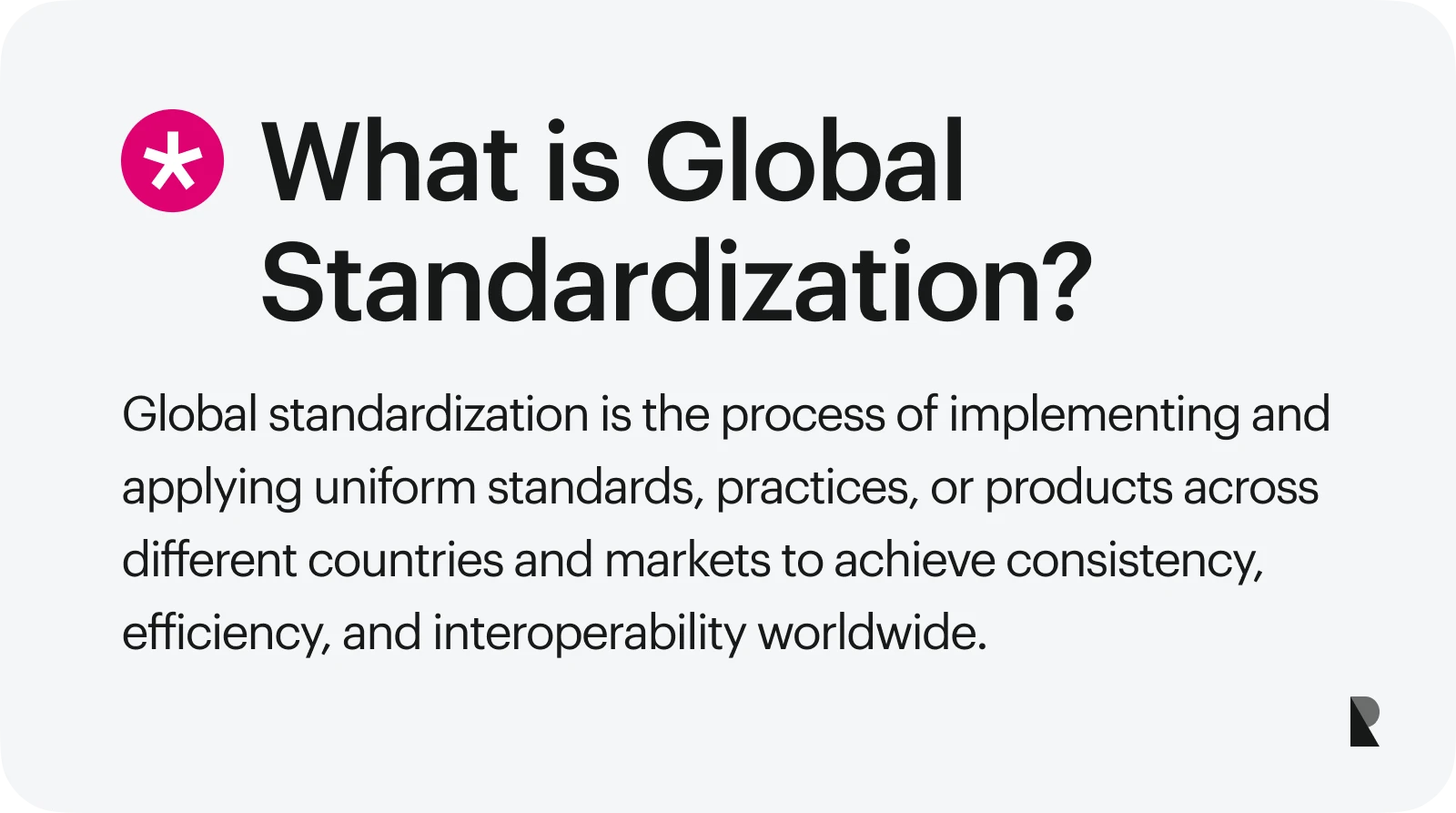
We’re seeing our commercial world become increasingly connected and accessible daily—to the point where brands start crossing borders faster than most products ship. Global standardization is now something far bigger than just a buzzword. It’s a fundamental strategy for companies expanding internationally—one that helps them deliver high-quality products, unify their messaging, and operate efficiently across regions.
From global supply chains to marketing campaigns, standardization supports creating products and services that are recognizable, reliable, and scalable. For any business looking to reach international markets, the question isn’t whether or not you should standardize—it’s how to do it in a way that honors product uniformity and regional nuances. This balance is why many brands turn to a brand strategy firm early on in their journey to ensure that their identity is consistent and adaptable.
As teams scale across regions, identity systems tend to fray: visual language drifts, tone splits, and assets multiply without a single standard. Global rollout exposes every inconsistency.
That’s why hiring a brand identity design firm at this stage can be transformative. Their experts codify color systems, typography, visual hierarchy, and brand usage guidelines—so every touchpoint, from packaging and presentations to digital campaigns, maintains the same recognizable quality.
By building an adaptable yet coherent identity, you give your global brand a scalable foundation that feels trustworthy and familiar everywhere it appears.
Global standardization implements and maintains consistent international market design, production, communication, and delivery practices.
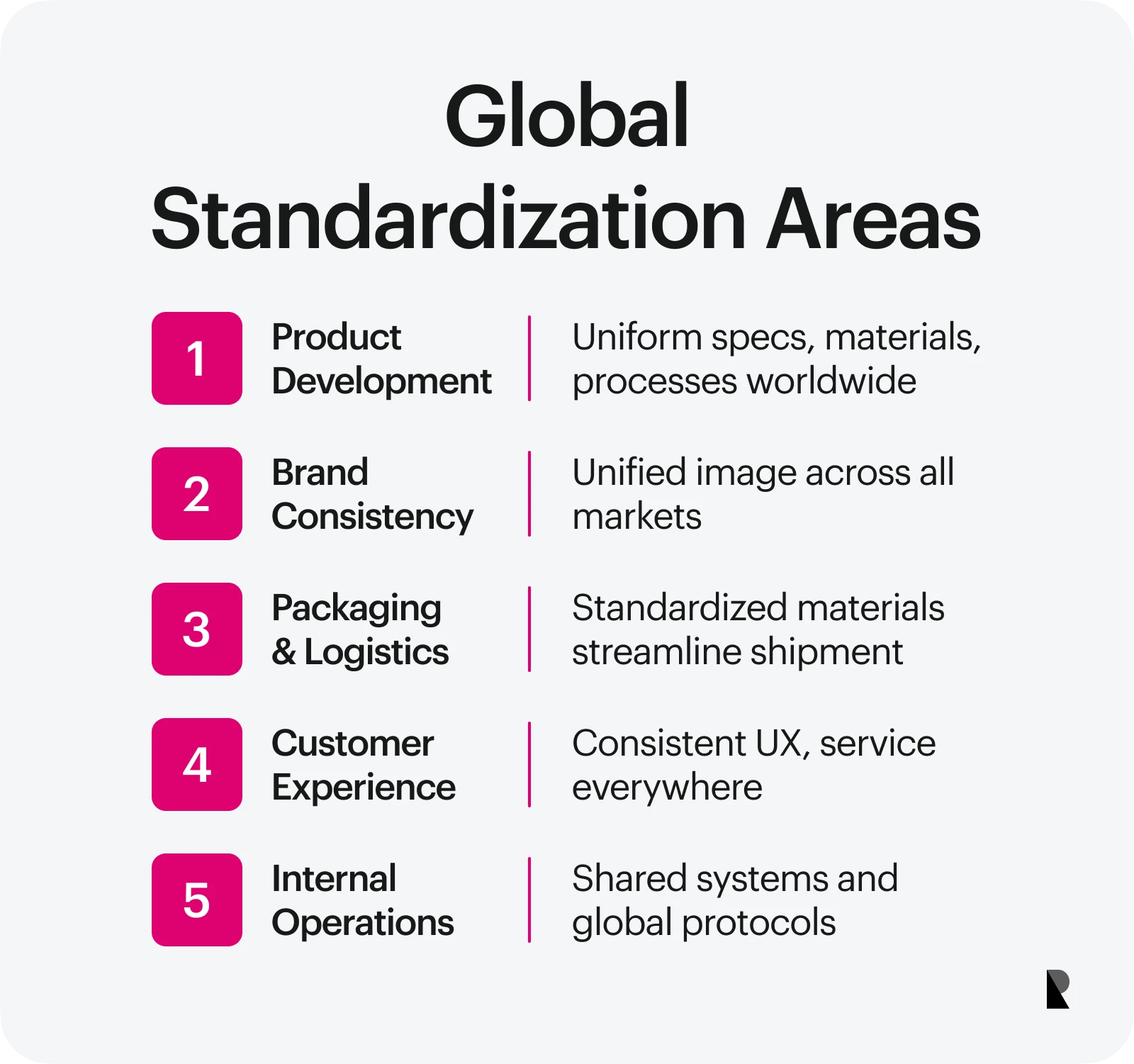
At its core, global standardization helps create cohesion. It ensures that customers experience the same quality, tone, and product function no matter where customers interact with a brand. Companies apply this principle to everything from product design and quality control to advertising, marketing strategies, and supply chain operations.
When we talk about global standardization at large, the idea stretches into five key areas:
- Product development and production: Using the exact specifications, materials, and manufacturing processes globally to maintain a quality product.
- Brand identity and marketing: Delivering a unified brand image (often called brand consistency) across all platforms and regions.
- Packaging and logistics: Streamlining shipment and storage through standardized materials and sizes.
- Customer experience: Ensure UX and service models always feel familiar, regardless of platform or country.
- Internal operations: Coordinating your teams globally through shared protocols, training, and systems.
This standardization strategy can eliminate confusion, make it easier to scale operations and simplify entering different markets.
Why Global Standardization Matters for Businesses
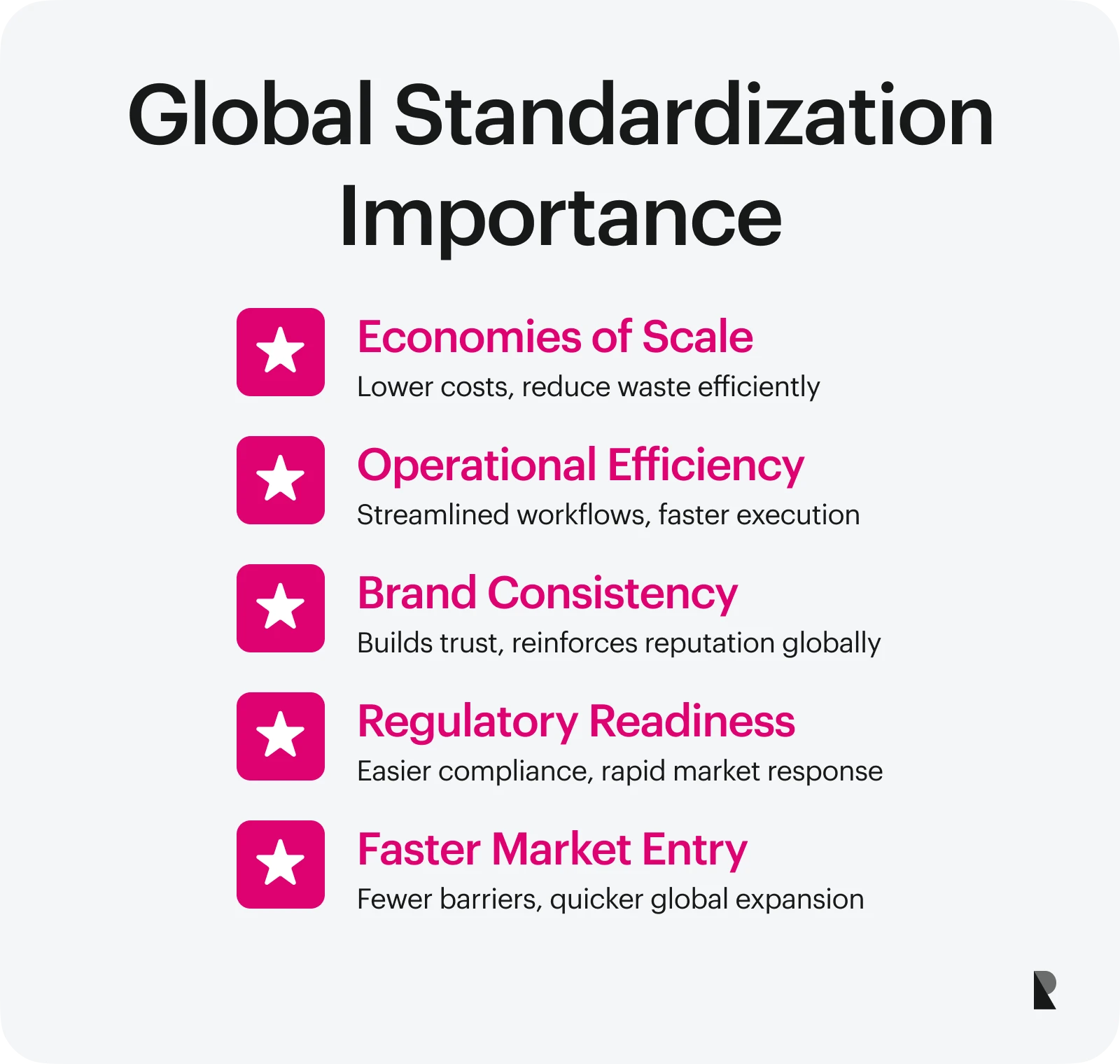
Economies of scale are a significant motivator. Brands lower production costs, cut waste by producing standardized products in bulk, and reuse campaign assets across different markets (when culturally possible). Operations become leaner and more sustainable, crucial in a global climate where resources are scarce — and consumers are increasingly environmentally conscious.
When marketing, design, and supply teams use one blueprint, operational efficiency increases. Internal teams spend less time reinventing the wheel and more time executing things smartly, enabling brands to meet regulatory requirements in advance and react faster to market shifts.
A standardized approach helps reinforce brand reputation. It signals consistency, which builds customer trust. Especially in saturated markets, consistency across packaging, design, and service can differentiate a brand from scattered or less organized competitors.
Most importantly, standardization enables faster entry into global markets. With fewer localization barriers and tested marketing strategies, businesses can act confidently — often gaining market share much faster than those who start from scratch in every region.
3 Main Benefits of Global Standardization
When done right, global standardization unlocks tangible value across your business. Here are three of the most impactful benefits.
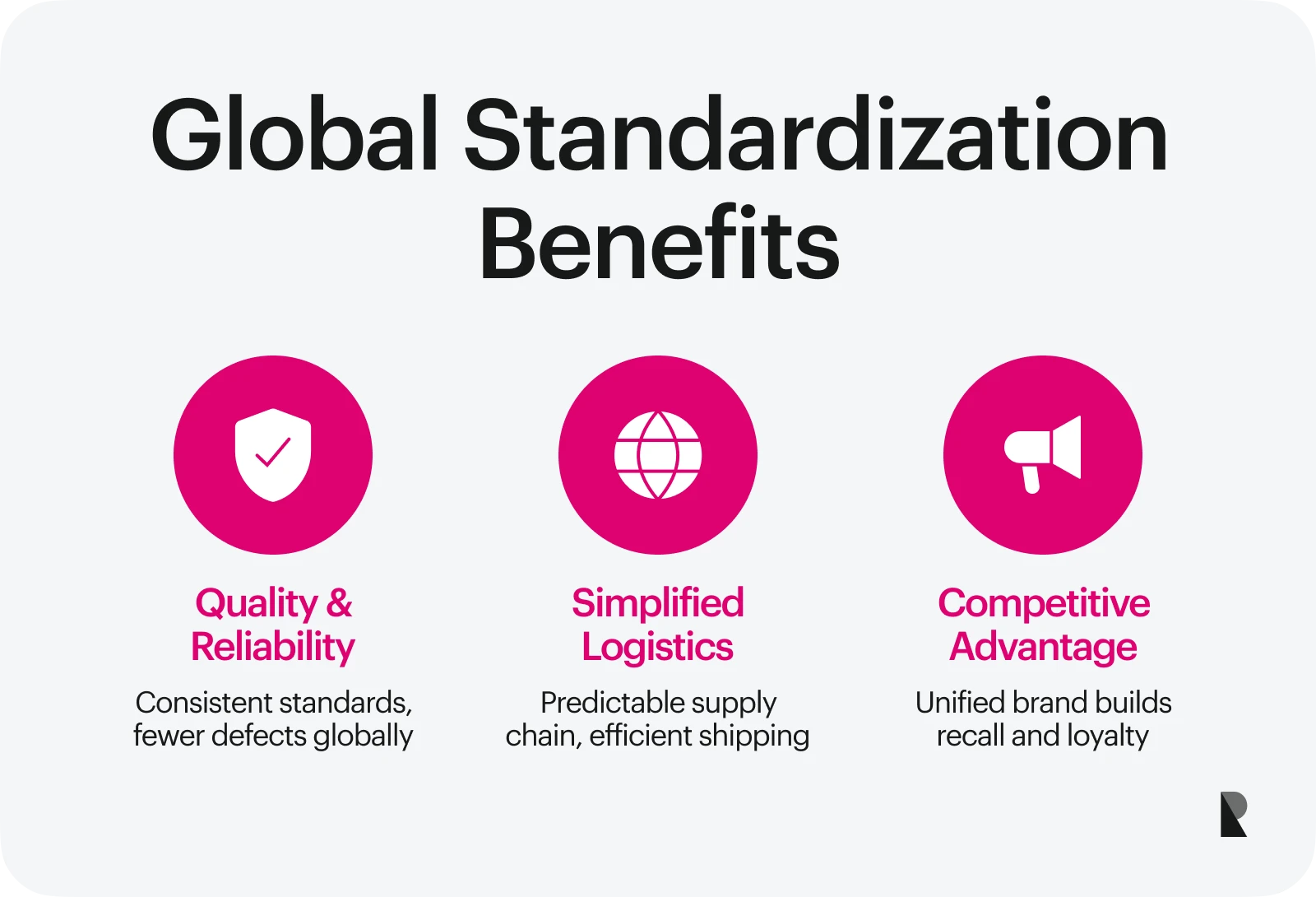
1. Increased product quality and reliability
Standardized systems are easier to monitor, and that’s a recipe for reliability. Brands that use a standardization strategy across production lines can consistently apply quality standards, catch defects early, and improve processes proactively.
Take Tesla, for example. Its global standardization strategy means that its vehicles — no matter where they’re produced — benefit from the same design language, build quality, and over-the-air software updates. That consistency builds trust and cuts down on support tickets.
Product quality isn’t just about avoiding defects. It’s about delivering the same excellence every time. That’s the brand promise that standardization helps you fulfill.
2. Simplified supply chain and logistics
Logistics run smoother when every package, label, and product format is predictable. Brands like Apple leverage this with almost surgical precision. Its products and services — from iPhones to charging cables — ship in near-identical boxes worldwide, reducing confusion and maximizing transport efficiency.
This kind of chain management also supports long-term customer satisfaction. When a product arrives on time, in pristine condition, and precisely as you expected, the post-purchase experience aligns with the brand expectations.
Packaging uniformity might seem like a minor detail, but it’s actually a vital part of a standardization strategy that reduces warehousing complexity, shrinkage, and transport delays.
3. Stronger competitive advantage
Brands that standardize smartly — and selectively — often pull ahead in crowded markets. Consistency across regions builds recall. Over time, customers associate the brand with trust and familiarity, which translates into loyalty.
Nike has long executed one of history's most recognizable global standardization strategies. Its “Just Do It” slogan, logo, and ad format are used worldwide — but the faces in those campaigns change. Nike maintains relevance at scale by anchoring itself to a unified message and approach while embracing target audiences locally.
This model proves a simple truth: a clear global strategy creates a competitive edge that local players struggle to match.
Challenges and Limitations of Global Standardization
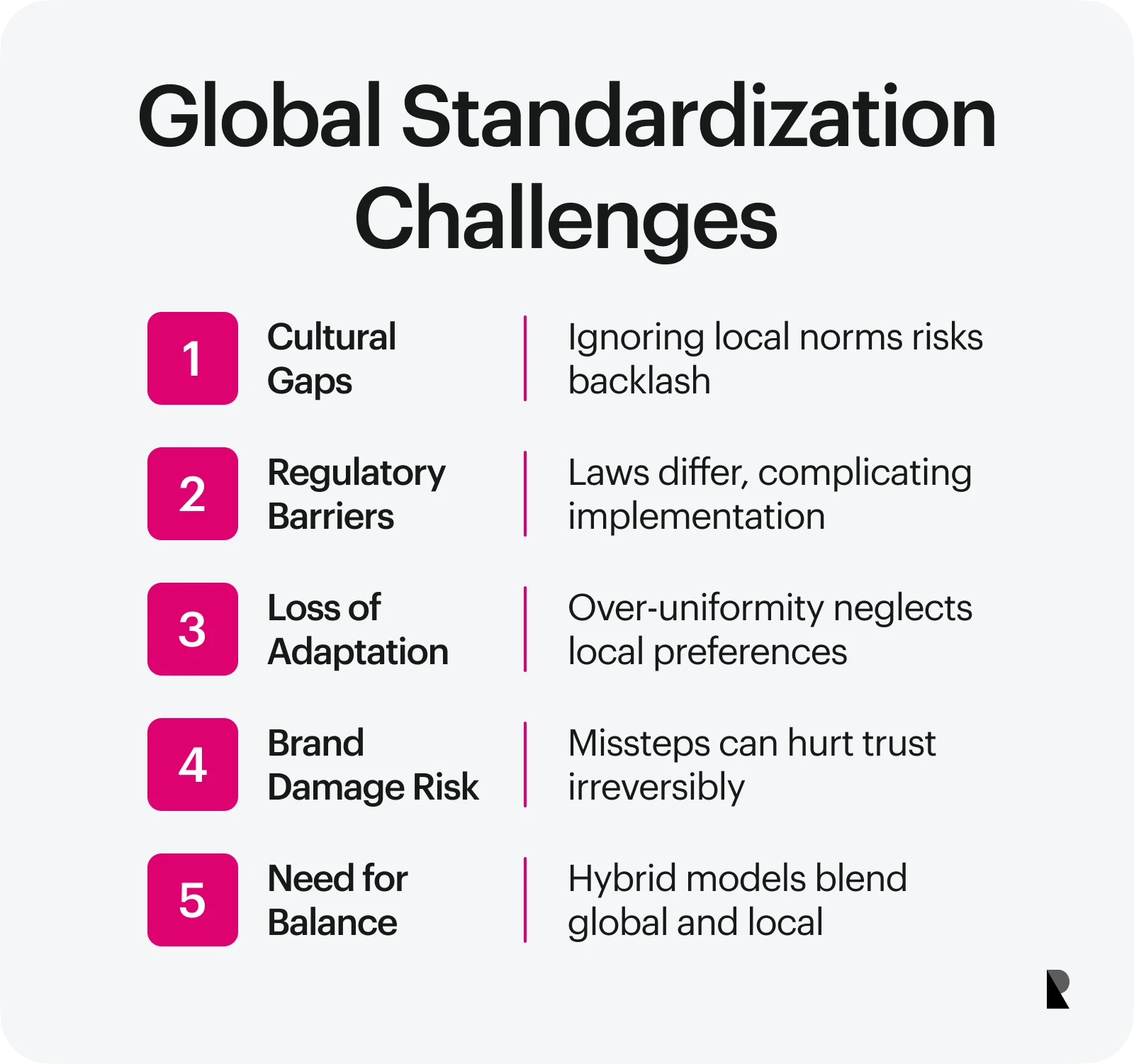
Of course, standardization isn’t perfect. Every powerful strategy has trade-offs, and this one comes with real risks when applied without nuance.
Cultural and regional differences
Standardization can backfire when it ignores local customs, beliefs, or preferences. Misreading a market doesn’t just lower sales — it can trigger a backlash.
McDonald’s offers a well-known example. Its global menu has signature items, but it adapts based on region. In India, beef is avoided; in Japan, you might find teriyaki burgers or corn soup; and in Switzerland, there’s a raclette burger (yes, that’s a lot of cheese). These changes acknowledge cultural norms that a rigid strategy might overlook.
Cultural missteps can cause irreversible brand damage. The most innovative brands use global guidelines but leave room for local reality.
Regulatory and compliance issues
What works legally in one country might be banned in another. From product claims to digital policies, regulatory requirements can make implementing a standardization strategy difficult.
Google’s limited presence in China offers a clear example. Its search engine, YouTube, and cloud services are heavily restricted — forcing the company to rethink its service model entirely in that region.
Global giants must account for differences in privacy law, advertising restrictions, and industry-specific rules when applying global standardization strategies.
Loss of local market adaptation
When a company focuses too heavily on global uniformity, it can lose sight of the local market. Preferences differ in tone, taste, and timing — ignoring them may leave users cold.
Starbucks demonstrates a hybrid model that works. Globally, you’ll see the same logo and core drinks, but its regional menus vary widely — with matcha lattes in Japan and dulce de leche frappuccinos in Latin America. This builds loyalty by celebrating local habits instead of ignoring them (which would arguably be an easier choice).
Harvard Business Review said it best more than five decades ago: “The smartest global strategies aren’t rigid—they’re rhythmic.” Brands need to standardize where they scale and localize where they resonate.
When and How to Use Global Standardization Strategies
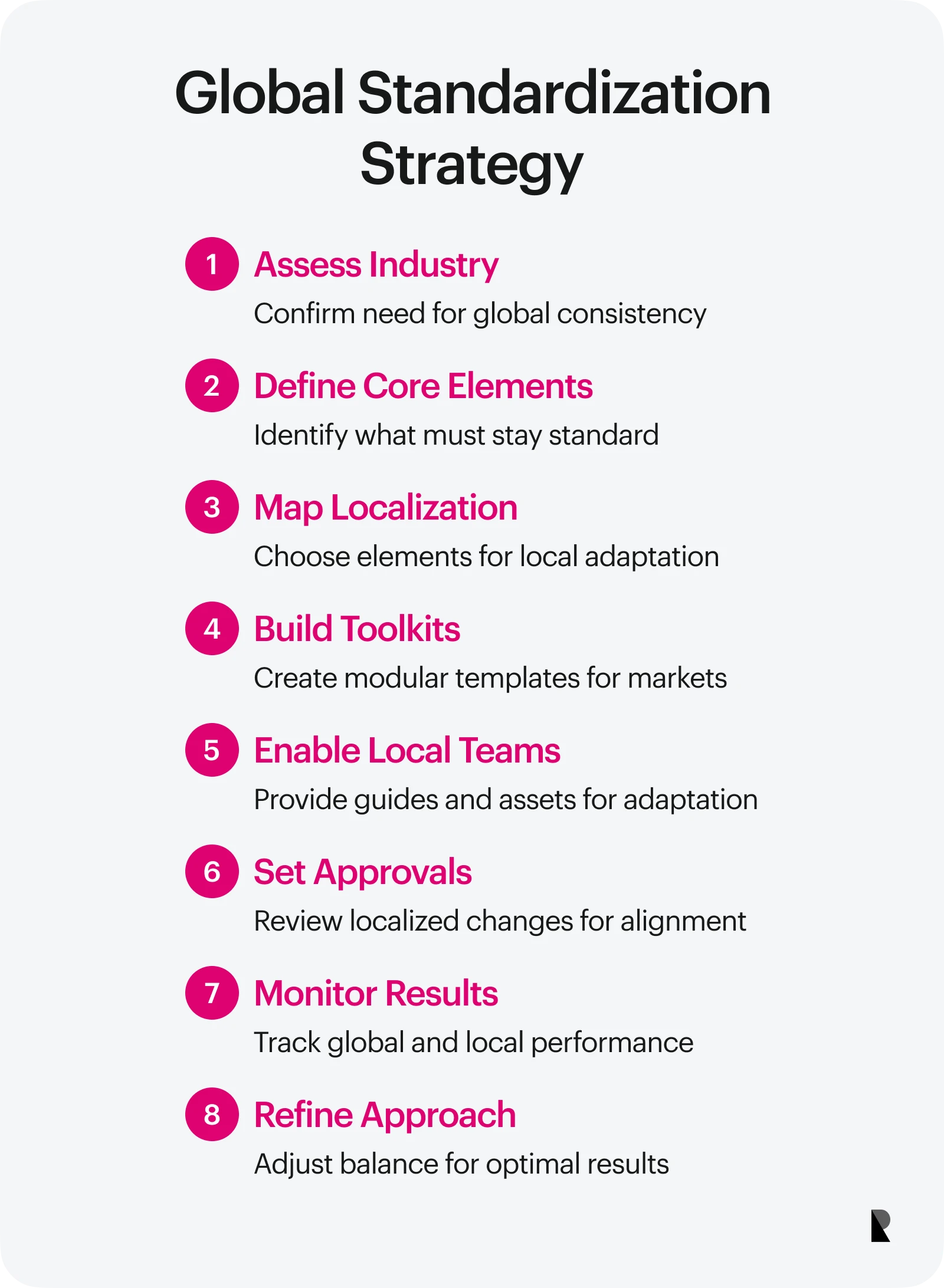
To build an effective global footprint, companies must understand when standardization drives results — and when localization plays a stronger role. Let’s outline the types of industries where global standardization thrives and how to strike the perfect balance between consistency and customization.
Identifying the right industries
Global standardization thrives in industries where product consistency, regulatory control, and operational scale are essential.
Technology companies like Apple and Microsoft build standardized devices and software systems that behave the same way worldwide. This delivers a seamless user experience across countries, boosts efficiency, and supports universal updates — a strong use case for a tightly controlled standardization strategy.
Pharmaceutical companies like Pfizer distribute identical drugs globally and are governed by strict quality standards. Manufacturing protocols must remain exact, making standardization a non-negotiable part of the business model.
FMCG giants like Coca-Cola and Nestlé also benefit from standardized formulations and packaging. Their products and/or services are designed to be recognizable worldwide, while local tweaks — like different sweeteners or flavor profiles — are handled with care.
These industries share a common trait: customer trust depends on uniformity. That’s what makes global standardization not just helpful but foundational.
Choosing between standardization and localization
Standardization doesn’t mean abandoning local insight and defining what needs to stay the same — and what can flex. For example, a marketing strategy might keep core brand messages and templates global but allow local language adaptations. A campaign theme can be consistent while visuals or taglines shift to reflect cultural preferences. This hybrid model supports effective communication without sacrificing efficiency.
An innovative global standardization strategy evaluates:
- The nature of the products and services (for example, if they are taste-based, tech-based, or culturally sensitive)
- The maturity of the brand in specific markets
- The importance of regional regulations and trust
- The role of brand equity in buying decisions
Rigid uniformity risks alienating customers. Full customization drains resources. The right move sits in between — a balance of structured standardization strategies and market-aware adaptation.
Creating and using modular strategies
Some companies even go a step further by developing “modular strategies.” These allow for a fixed set of global assets — templates, visuals, product frameworks — that can be recombined or tailored for each region. Think of it as a worldwide toolkit with local levers. This model works particularly well in the fashion, software, and hospitality industries, where aesthetics or behavior vary widely. It also helps brand teams maintain effective communication with local partners, empowering them to stay aligned while reacting to their market conditions.
The global standardization strategy becomes a flexible framework rather than a rigid rulebook. It also supports eliminating the need to start from scratch every time a new market is entered — a critical advantage in competitive industries. This operational agility is becoming essential as brands try to balance speed with nuance. The faster the expansion, the more vital that adaptable standardization becomes.
Case Studies: Successful Global Standardization Strategies
Some of the best-known global brands have refined their playbooks by learning when to align and when to adjust. These examples show how standardization works and how brands precisely tailor it.
McDonald’s: standardized menu with local adaptations
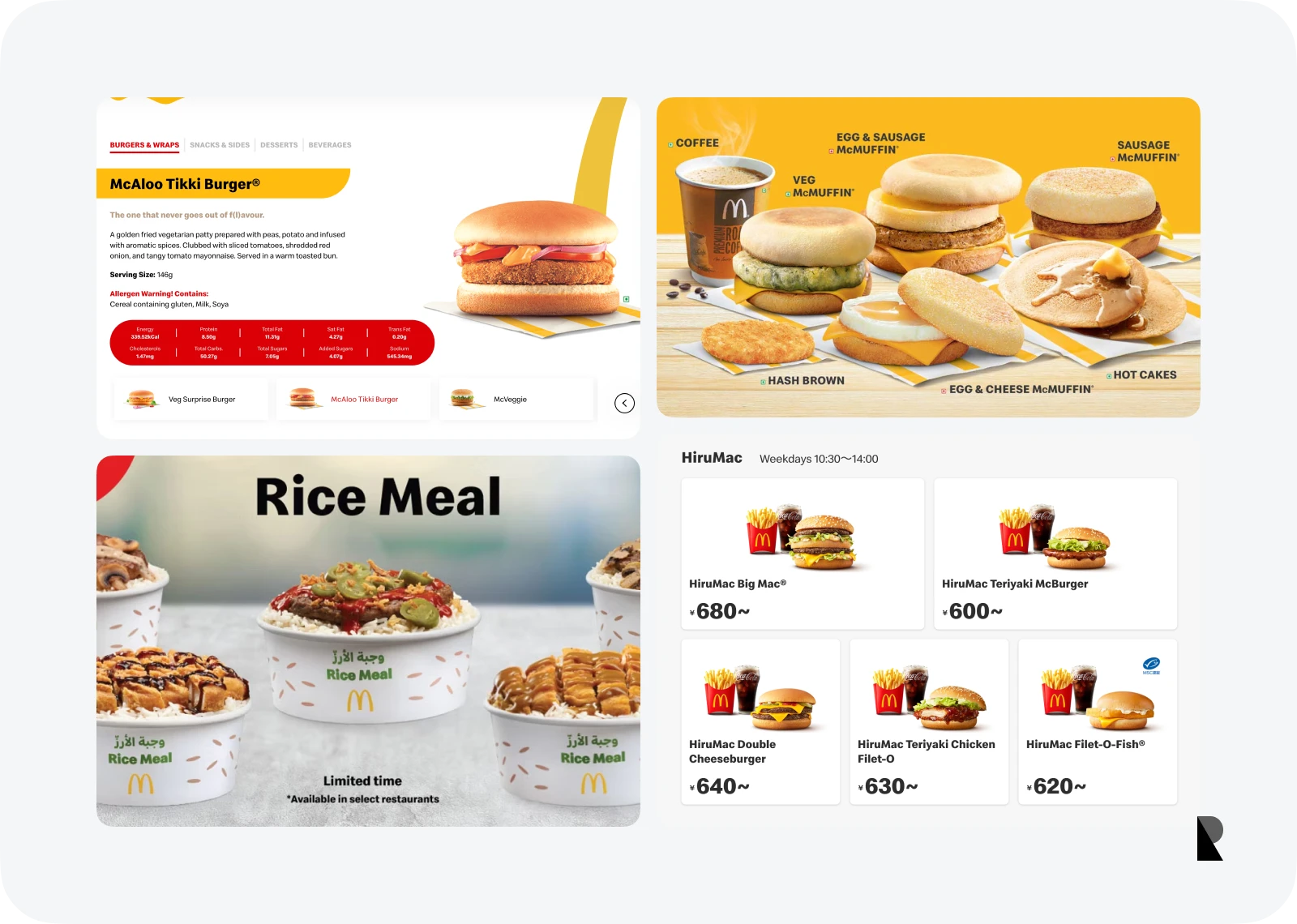
McDonald’s operates in over 100 countries, and its strength lies in familiarity. The Big Mac, golden arches, and pricing models are globally consistent — but the menu adapts. Vegetarian options in India, shrimp burgers in Japan, and rice dishes in the Philippines are part of its strategy to respect regional tastes while maintaining a strong global identity.
This standardization strategy creates operational predictability while building brand love through customer experience personalization.
Apple: consistent design and user experience
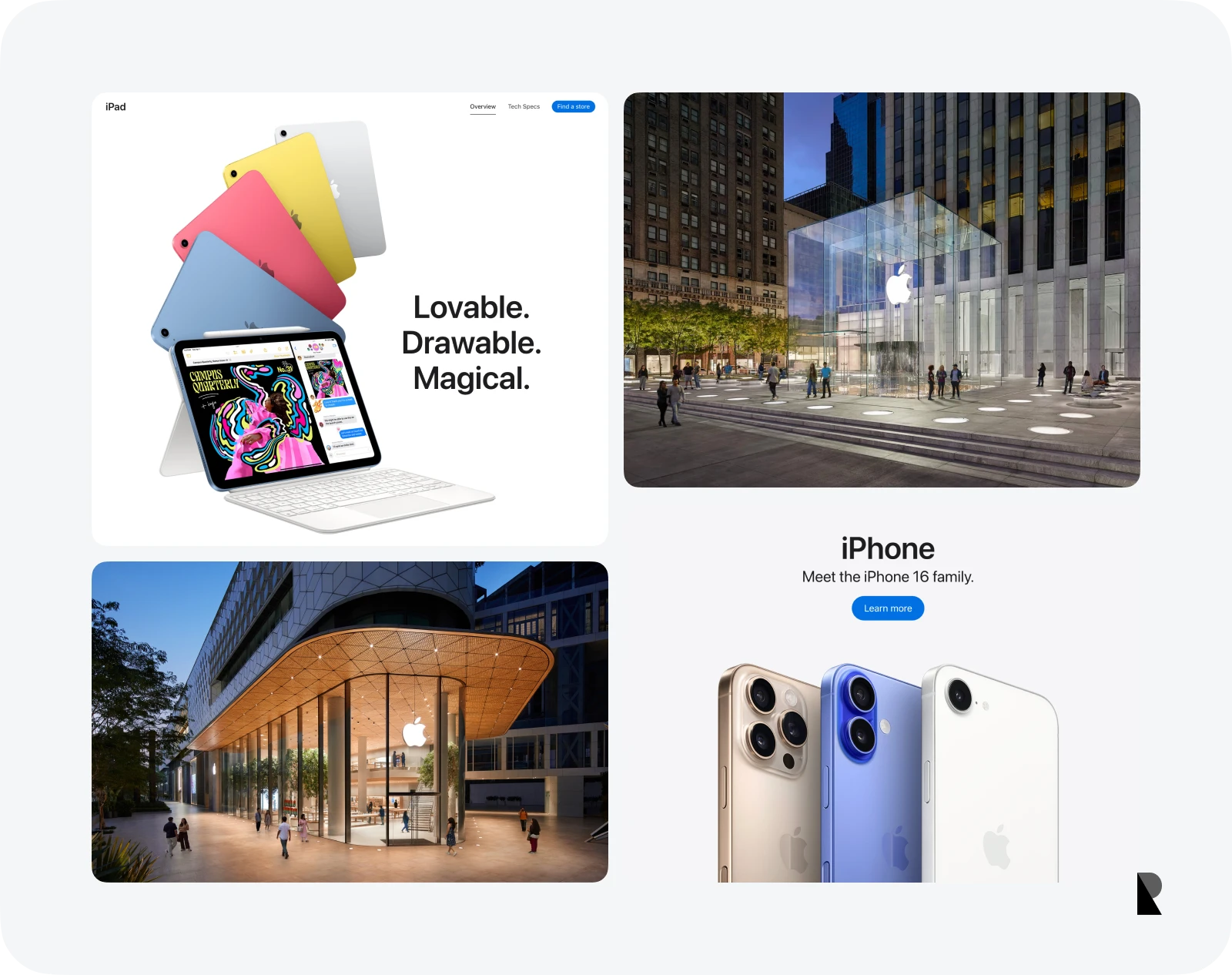
Apple’s commitment to product uniformity is central to its success. Whether you buy an iPhone in New York or Nairobi, the hardware, packaging, and interface are nearly identical. This provides a uniform customer experience that reinforces trust and premium positioning.
That said, Apple localizes services when necessary. Apple Pay functionality differs depending on market infrastructure, and regional support teams tailor onboarding for new users. It’s a fine example of global standardization executed with awareness.
Nike: global branding and marketing standardization

Nike’s marketing is globally unified — same logo, same tagline, same energy. But it also excels at regional relevance. Its campaigns feature local athletes, languages, and sports preferences, adapting to market expectations without veering from its unified brand story.
This mix has helped Nike to maintain global dominance while growing in diverse markets from Southeast Asia to South America. It’s proof that global standardization strategies don’t have to feel generic.
Conclusion
Global standardization is more than just a corporate playbook — it’s a growth lever. It allows businesses to scale faster, maintain product quality, reduce duplication, and build cohesive brands that resonate across regions. For global companies, it’s a matter of alignment, efficiency, and long-term competitiveness.
However, real success lies in understanding that standardization doesn’t necessarily mean sameness. The strongest global standardization strategies leave room for cultural nuance, legal reality, and user preference. Brands that find the right blend — structure with flexibility — emerge stronger in global markets.
So, standardization offers many benefits, whether you’re creating a global marketing strategy, designing cross-border products or services, or building a brand identity that lives across different cultures. Just remember to calibrate — don’t just copy and paste. Because when done right, global standardization doesn’t remove your differences. It makes it possible to thrive in it.
Jun 23, 2025
